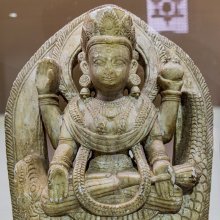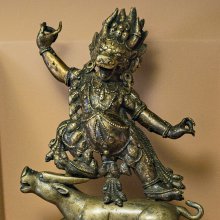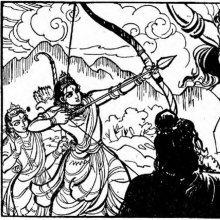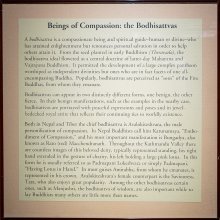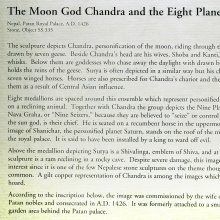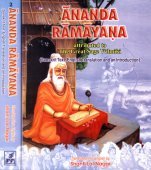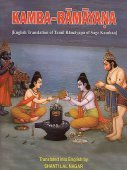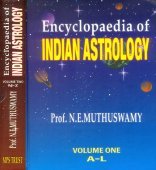Personification: 1 definition
Introduction:
Personification means something in Hinduism, Sanskrit. If you want to know the exact meaning, history, etymology or English translation of this term then check out the descriptions on this page. Add your comment or reference to a book if you want to contribute to this summary article.
Images (photo gallery)
(+1 more images available)
In Hinduism
Shilpashastra (iconography)
Source: Shodhganga: Elements of Art and Architecture in the Trtiyakhanda of the Visnudharmottarapurana (shilpa)Personification is seen to be used in the context of Painting, according to the Viṣṇudharmottarapurāṇa, an ancient Sanskrit text which (being encyclopedic in nature) deals with a variety of cultural topics such as arts, architecture, music, grammar and astronomy.—Personification is one of the most popular and frequently used techniques among the artist through which an object or an abstract idea is portrayed as a living being. Sanskrit literature bears a bundle of example of personification portrayed by different poets. In Sanskrit, the figure of speech called Samāsokti is used to denote the ways of personification. In the Viṣṇudharmottarapurāṇa, the technique of personification is seen to be used in the context of Painting also. The rules of representing the pictures of some non living things through personification are nicely described in this work.

Shilpashastra (शिल्पशास्त्र, śilpaśāstra) represents the ancient Indian science (shastra) of creative arts (shilpa) such as sculpture, iconography and painting. Closely related to Vastushastra (architecture), they often share the same literature.
See also (Relevant definitions)
Full-text (+257): Aurmya, Mamhama, Paravinda, Mahapara, Devagiri, Madhyamapurusha, Kukubha, Gudakari, Ahama, Maunjya, Rathecitra, Nanapattraka, Diptarupin, Mohama, Rathaprota, Anuragini, Rathakritsna, Murti, Vajravarahi, Dhunvant.
Relevant text
Search found 130 books and stories containing Personification; (plurals include: Personifications). You can also click to the full overview containing English textual excerpts. Below are direct links for the most relevant articles:
Chaitanya Bhagavata (by Bhumipati Dāsa)
Verse 1.13.21 < [Chapter 13 - Defeating Digvijayī]
Verse 3.7.76 < [Chapter 7 - Pastimes in Śrī Gadādhara’s Garden]
Verse 1.2.138 < [Chapter 2 - The Lord’s Appearance]
The civilization of Babylonia and Assyria (by Morris Jastrow)
Part I < [Chapter V - The Cults And The Temples Of Babylonia And Assyria]
Part I < [Chapter IV - The Gods Of Babylonia And Assyria]
Part II < [Chapter IV - The Gods Of Babylonia And Assyria]
Yoga Vasistha [English], Volume 1-4 (by Vihari-Lala Mitra)
Chapter IX - Viswamitra’s wrath. and his enraged speech < [Book I - Vairagya khanda (vairagya khanda)]
Chapter LXXXIII - Sight of the mundane god < [Book VII - Nirvana prakarana part 2 (nirvana prakarana)]
Chapter XCI - Interpretation of the parable of the elephant < [Book VI - Nirvana prakarana part 1 (nirvana prakarana)]
Cosmic Perspective in Chaucer < [April - June 1972]
Personified Devotion < [October 1938]
Nature The Best Teacher < [October – December, 2002]
Garga Samhita (English) (by Danavir Goswami)
Verse 1.2.43 < [Chapter 2 - Description of the Abode of Śrī Goloka]
Vishnudharmottara Purana (Art and Architecture) (by Bhagyashree Sarma)
7(f): Personification Created by Painting in Portrait < [Chapter 5 - Painting and Image Making]
7(a): Portrait of Men and Women < [Chapter 5 - Painting and Image Making]
Related products
